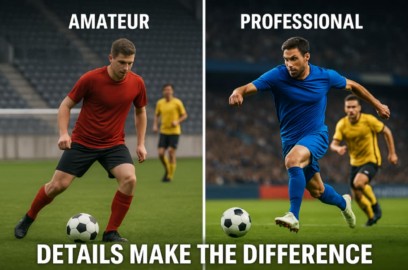
Many players dream of moving from the junior or amateur level to professional football. This transition does not depend only on talent or physical attributes. The key role is played by technical elements, which a player must master to the level of automation – so that they can be performed under pressure, at full speed, and in match conditions. These are exactly the details that determine whether a player is ready to compete with professionals.
Below are five fundamentals that separate an amateur from a professional player.
-
DIRECTIONAL FIRST TOUCH – THE FIRST CONTACT THAT CREATES AN ADVANTAGE
Amateurs often stop the ball under themselves, losing time and allowing the opponent to recover. Professionals use the first touch to open space – controlling the ball directly into the direction they want to play or attack.
-
Exercise: directional first touch under pressure from a partner in a small space, with the obligation to exit with the first contact in a set direction.
-
ONE-TOUCH PLAY – SPEED OF DECISION AND RHYTHM
At the professional level, game tempo is crucial. The ability to play the ball without unnecessary touches makes the team faster, harder to press, and able to break down the opponent’s defense.
-
Exercise: rondo (possession game) with a maximum of one touch; introducing variations under time pressure and with additional defenders.
-
PRECISE PASSING UNDER PRESSURE
At amateur level, passes are often too slow or inaccurate. A professional adjusts the power, speed, and direction of the pass to the situation – even when pressed by an opponent.
-
Exercise: passing under time limits (e.g., 2–3 seconds to release the ball) in tight spaces; adding defenders to force decisions.
-
DRIBBLING WITH SUDDEN CHANGE OF PACE
Dribbling is not just about tricks – at the professional level, the key is creating the illusion of calm before exploding with acceleration. The ability to change rhythm instantly gives the advantage in 1v1 duels.
-
Exercise: slalom with the ball finished with a maximum sprint over 10–15 meters; 1v1 games in small spaces with mandatory quick change of direction.
-
EFFECTIVE FINISHING
Professionals rarely need many attempts. What sets them apart is the ability to strike the ball at the right moment and in the right way – accurately, even under pressure.
-
Exercise: finishing after a quick first touch (maximum 2–3 touches), shots after passes in motion, and finishing with limited time for decision-making.
SUMMARY
The difference between an amateur and a professional footballer lies in the details. These five elements – directional first touch, one-touch play, precise passing under pressure, dribbling with sudden change of pace, and effective finishing – determine whether a player can play fast, efficient, and with an advantage over opponents.
Each of these skills can be trained individually or in small groups, but the key is intensity and realistic match situations – training must mirror match conditions so that later in games it works as a natural reflex.





